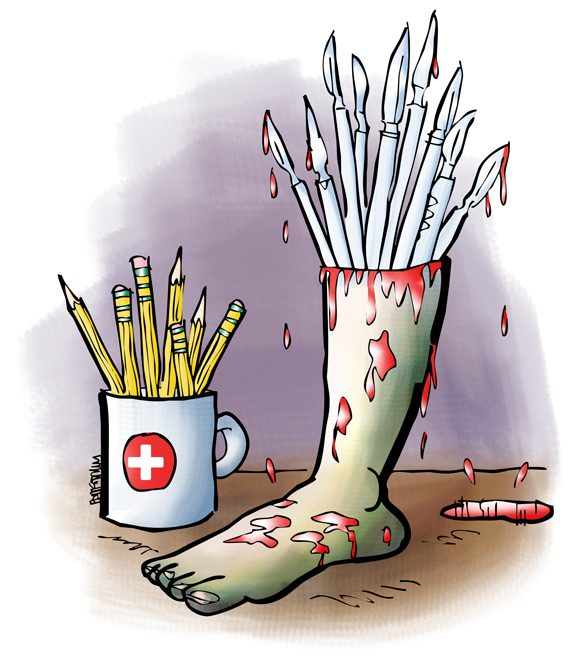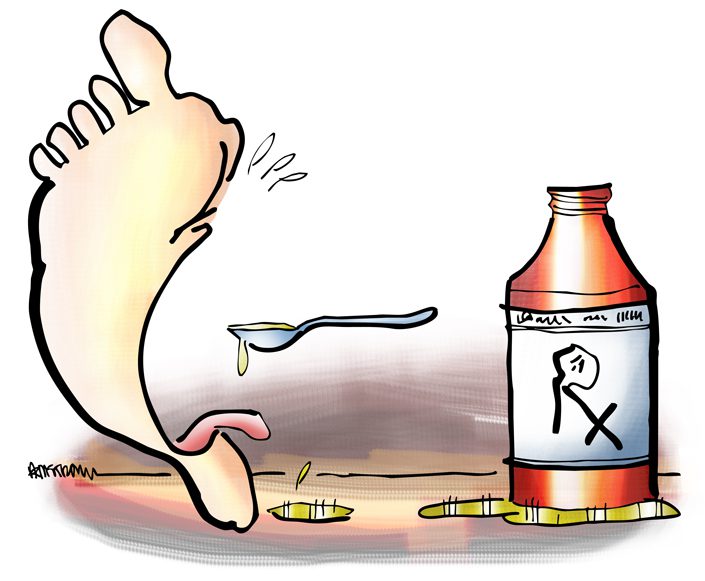
Say you buy your own story. You buy a copy of your medical records because you’ve come to realize the story you’ve told others is a whitewashed version of your own life, because you need to know, in the most brutal, clinical terms, who you are. Say even though this is your story you still must pay a copying fee, must pay before you can hold that thick envelope in your hands. When the woman hands you the records, you can’t help but feel you are buying yourself back, at the reasonable price of fifty-one dollars and sixty-two cents. And just like that, the story of your body, the version you know, is undone. Just like that, you meet yourself for the first time.
*
You should know your doctor is your author. You should prepare yourself for the case notes—he is not writing to you, he his writing to himself. It’s like you’re eavesdropping on a conversation and then you suddenly overhear your name.
*
Or consider it this way: this is just a story. This is a book with a few sympathetic characters, a kind of Unsolved Mystery meets Choose Your Own Adventure. How exciting! Think about it in those terms. Just try.
*
You should also know that this story is missing some key elements. Of course, there’s what’s been lost to illegible handwriting and poor copy quality, but let’s not overlook the fact that the story begins partway through. Think of this as an origin story without an origin. This is as close as you can get.
*
This is where it starts, then, a clinic visit to your new doctor when you are two years old.
He writes:
…I believe that even if she is a multihandicapped, probably she has various neuromuscular components of involvement. I believe that these must be considered
neuromuscular teratogenic type feet that require extensive surgery and holding. Once they show a tendency to recur to deformity as quickly as they do, the long-term outlook must be moderately guarded and aggressive intervention undertaken at an early stage.
This is not a diagnosis, but a naming of the parts: for you are fearfully made. The monstrosity you house. What rough beast.
*
A pre-operative document from the same year:
This is a two year, nine month old female who presents with resistant club feet bilaterally.
She was diagnosed as hypotonic quadriparesis.
She is admitted for further surgical release of her club feet.
Physical Examination: Shows a pleasant, alert female child.
This is what you do know, what you’ve always known: club foot is a birth defect where one or both feet rotate internally, at the ankle. The heel is also lifted, forcing the foot to point downward. Imagine pointing your toes, fully extending your ankle; then imagine that position turned 90 degrees, both feet facing each other head-on. A person with club feet would appear to walk on her ankles or on the outer edges of her feet.
Imagine pointing your toes, fully extending your ankle; then imagine that position turned 90 degrees, both feet facing each other head-on. A person with club feet would appear to walk on her ankles or on the outer edges of her feet.
The medical term is talipes equinovarus. Equino, from the Latin for ‘horse-like,’ and varus, meaning, ‘turned inward’: a club foot, in many ways, resembles a horse’s hoof. The condition is extremely common, but usually mild. Surgical intervention is rare.
But this is also where the story begins to splinter. You look up hypotonic quadriparesis, a term you’ve never seen before. You are beginning to understand that you do not understand.
Paresis is a form of partial paralysis, from the Greek parienai, meaning ‘let go.’ As if to be paralyzed is a release, a loosening of that which binds you. Try to understand: you must undo the body, you must unmake what’s already unmade.
*
But then there’s paralysis as a response to fear, a going limp in the animal’s jaws. In a way, you cultivate immobility. You still your body while many hands tend you. You become a moored vessel. If you do not move or draw sudden attention to yourself, no one will ask anything of you. You wear a lot of pants. Years later, when someone else undresses you, you go limp in the animal’s jaws. Tell me about your little freak feet, he says afterwards. Try to understand: everyone owns your body but you. Make the story palatable. Don’t upset anyone. Leave out the parts with blood.
*
If you’re being honest here, what parts then remain? Who then, or what then, do you become? The answer is always, by necessity, someone else.
*
The unrelenting detail of another surgical report. This is a surgery of release, of lengthening the heel cords. But this is also where the body becomes illegible. You are still two years old.
The report reads:
The normal anatomy was grossly distorted secondary to marked formation of scar tissue from the previous procedures.
The report reads:
Along the medial aspect of the talus navicula was extensive scar tissue, again, obscuring the normal anatomy. It was very difficult to identify the subtalar joints.
The report reads:
Ligaments all released, we were still unable to bring the foot out of varus and into a plantigrade mode.
*
It might be comforting to think of the body as headstrong, as hell-bent on sticking by its guns. But that’s to conflate the body with its programming. The body is malleable, a thing to manipulate. It’s the genetic code that won’t give way. You say, body, straighten up and fly right, but the body’s rules and regulations say, not so fast, not so fast. We are under strict orders. This is a no fly zone.
*
Or, the genetic code might say, as the doctors have said, I am merely expressing “a tendency to recur to deformity.”
*
Tendency: tendentia, from tendere, ‘to stretch.’
Tendency, tendon, tender, tend. What can’t be righted, stretch. Recur. Recur. Recur.
*
You can’t talk back to your genetic sequence. You do not know what part of you to reprimand. Everyone focuses on your legs, on your feet. You do, too. You can even look at your feet while speaking firmly to them in a disapproving, maternal tone. Other times you encourage them like they are your enthusiastic children, eager to please. You say, today we are going to the park. Let’s go see the neighborhood. Let’s take in all the sights. When they cooperate, you feel proud of them. When they don’t, you feel parental guilt. It’s hard to know at what point you begin to understand these feelings as self-directed. Easier if the body is not self. Easier if the self does not reside within a shabbily constructed house.
*
You love good, old-fashioned, dilapidated buildings. You also love three-legged dogs. For a brief while, you think you might become the kind of person who fixes things, but it turns out those kinds of jobs require a lot of standing on your feet all day, and you are discouraged from pursuing these occupations. You will not be a veterinarian. You will not be a ballerina, either, but that’s a childhood dream many give up. And so you are part of a greater sisterhood, the sisterhood of I will never be a ballerina. Get used to sitting on your keester, sister.
*
You are skimming the records for the parts you know by heart, the reports that correspond to certain scars, certain family stories. You’ve always told everyone that you can’t move your ankles because they are fused. You can’t find this procedure.
You come back again and again to the part about paresis, about paralysis. Understand, an unclenched hand can still resemble a fist. Imagine your ankles as fists, blindly punching their way down the street. Does this comfort you? Does this upset you? I am trying to tell you about my little freak feet. Do you understand? Can you follow?
*
With each recurrence comes another procedure, another round in the operating room, another surgical report. Most write-ups end with the phrase, the patient tolerated the procedure well. Most write-ups begin with the administration of an anesthetic of sorts. The drugs vary depending on the severity of the procedure. The effects vary with the severity of the drug.
Sometimes you are conscious for these procedures. Sometimes you are not. You are always given a drug that erases these events from memory. These records, these documents, become the source of your erasure. These documents contain the details your memory cannot. The effects vary with the amount of time you spend immersed in the report. The effects vary given which terms you decide to look up.
*
The idea of control is essential for controlled substances. This should go without saying. Consider this description of ketamine, from Encyclopedia Britannica:
Unlike inhalation anesthetics or sedative anesthetics (e.g., narcotics and benzodiazepines), ketamine does not depress respiration or other basic functions of the central nervous system. Thus, ketamine has a relatively wide margin of safety. In addition, it is distinct from other anesthetics because it has three major effects: analgesia (pain relief), hypnosis (sedation), and amnesia. The drug is known particularly for its ability to induce a dissociative (cataleptic) state, which is characterized by a lack of pain sensation, unconsciousness, and increased muscle tone. These characteristics are often accompanied by open eyes, jumping eye movements (nystagmus), and involuntary limb movements.
*
Sometimes you can read the reports as if the patient isn’t you. Sometimes phrases, such as, the toes were warm to touch, make your breath catch in your chest. Do you understand? I am becoming my own witness.
*
Or, consider these drugs in alternative settings. From the Wikipedia page for propofol:
The Missouri Supreme Court decided to allow the use of propofol to execute prisoners condemned to death. However, the first execution by administration of a lethal dose of propofol was halted on 11 October 2013 by governor Jay Nixon following threats from the European Union to limit the drug’s export if it were used for that purpose.
*
 The danger in becoming a witness is becoming too attached. You get upset when you learn the drugs you routinely were given (see: general anesthesia agents, any and most, propofol notwithstanding) were used to execute prisoners. You should not, rationally speaking, feel some kind of relief that you are living, or guilt that you are living, or question the nature of living. Some of the drugs have beautiful etymologies. Others are named after chemical compounds. Is it easier if you know the history of these drugs? I am trying to tell you, in no uncertain terms, where I’ve been.
The danger in becoming a witness is becoming too attached. You get upset when you learn the drugs you routinely were given (see: general anesthesia agents, any and most, propofol notwithstanding) were used to execute prisoners. You should not, rationally speaking, feel some kind of relief that you are living, or guilt that you are living, or question the nature of living. Some of the drugs have beautiful etymologies. Others are named after chemical compounds. Is it easier if you know the history of these drugs? I am trying to tell you, in no uncertain terms, where I’ve been.
*
This, an exercise in self-creation or self-annihilation, because, yes, those can sometimes be the same thing. Example: these medical records. Example: these pages I am writing. You and I are the same. You are becoming me. I am becoming you. It’s happening now. Consider this your first act of letting go, my first act of grabbing the bull by the horns. Imagine the unclenched hand that still resembles a fist. How will I use it? Who will you reach for?
***
Rumpus original art by Mark Armstrong.





